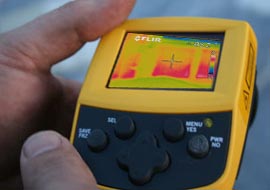Complete Inc.’s Case Studies
These are cases where Complete, Inc. was hired to assess the damage and/or restore the damaged property.
Wind, Flood, Fire and Water Claims
Water damage to structures and contents can become the driving costs after wind, flood, fire or builder liability claims. Many times it is not the damage from the tree through the roof or a burst pipe, but rather the resulting damage that can get a person in a tight spot with their loss. The affect of water on a structure can be the most difficult to contain and of the highest cost. Water affects different structures in different ways. I will share some of the common issues by claim type and try to relay the mitigation techniques that we have seen work over the years.

Flood – Obviously flood is water damage, but the type of loss can be very different depending on the type of flooding a property receives. The losses from flood can range from velocity flood knocking out structural supports to slow rising water that comes up and then goes away to when it doesn’t go away quickly like in New Orleans after Hurricane Katrina or the river flooding in the Midwest. The time that flood water spends in a house and the pollutants carried in flood waters can vary greatly and determine the likelihood of a successful restoration. Short term flood losses can be restored with a simple removal of the water damaged building components and application of a mildewcide along with the inclusion of dry interior air either created manually with equipment or by outside, non-humid air being circulated to the inside. These are the cases where one will see two to four feet of drywall removed from the finished floor elevation up.

Wind – The difficulty with wind damage, especially in newer better built structures, is the rain that typically gets inside the structure after the removal of the weatherproofing exterior materials, windows, roof or siding. During Hurricane Ivan 15.79 inches of rain came down the night of the storm in the Pensacola, Florida area. That is a column of water 15 inches tall at every opening. The fact that mold is ubiquitous means it will form anywhere there is cellulose, water and preferably darkness. This is the recipe for many homes after a hurricane when the occupants have evacuated, especially on barrier islands where the access after a storm is limited. Very often it will take weeks before municipalities and local government will allow re-entry as they deal with utilities failure. In these days and weeks water damage can quickly become mold and require expensive remediation. Careful and quick action is essential in the days following a loss.

Fire – As if the fire itself was not bad enough the method to extinguish it is even worse. The water from fire hoses carries the chemicals released in a fire to every nook and cranny throughout the structure. We have taken apart homes that seemed to have been restored of the fire damage, only to find many gallons of carbon and soot-filled water being held in the crawl space above a vapor barrier. Fortunately, you can typically rely on gravity to pull water downward in a structure; unfortunately, it leaves a greeting card of damage all the way down.

Water Intrusion – These are properties that have become damaged as result of the seepage of water typically propelled by air pressure. Air pressure can either be negative inside a building pulling water in through bad flashing or positive from wind pushing water into the building. Both are bad and, with the use of cellulose building materials so prevalent in the U.S., they can cause extensive damage to the interior components of a home or business. Oriented Strand Board is a great example of a product uniquely susceptible to water damage, mold and rot. Rot is simply water damage that has developed over time, resulting in the hyphae being absorbed and breaking down the cellulose product.

Water Loss – This is the name for a claim that is just that… a water loss. Typically, these are straight forward losses as long as the owner, or some person, is available to mitigate the damages as they are known. The only time a water loss will get away from you is when the property is vacant and then the loss can become something more. We have seen instances where as much as 50,000 gallons of water are let go from a burst pipe and the leak goes undetected. In one instance we, saw a pier become unstable due to the draining of the water under the house – Big damage from a little problem.
Complete, Inc. is a licensed, general contracting and construction consulting firm that specializes in the resolution of wind, flood, fire and water intrusion claims throughout the Southeast. We use FLIR thermal imaging and GE moisture meters to map the water in a property. Our job is to confirm that a property is dry or find where the water is and where it is not. Call the company the pros choose, call Complete.
Information was compiled by Complete, Inc., and the content of this document is the sole property of Complete, Inc. and not to be reproduced without written permission.
